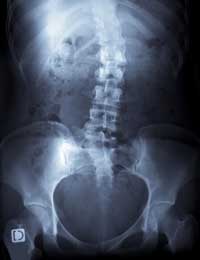Scoliosis Overview
Scoliosis: the spine curving abnormally in 1 or more places. Various types of scoliosis can occur.

What is Scoliosis?
Scoliosis is a musculoskeletal disorder that adversely affects the shape of the spine (backbone). The term for this condition is derived from an ancient Greek word used to describe something obliquely bent or crooked - skoliosis. Basically, scoliosis is when the spine curves abnormally in one or more places.
The spine is composed of bones called vertebrae. Normally, when viewed from behind, these bones (vertebrae) run down the back in a straight line. There are normal (front-to-back) curves of the spine; however, scoliosis is a side-to-side curvature of the spine. Therefore, a scoliotic spine (when viewed from behind) will not be straight and may instead look like the letter "C" or "S", due to the side-to-side (right-to-left) curvature.
Types of Scoliosis
An abnormal curvature of the spine can occur at any age and from a variety of causes. Therefore, scoliosis can be divided into a number of different classifications, each with its own unique features and type of treatment.
The main types/classifications of scoliosis include:
- Idiopathic
- Infantile Idiopathic Scoliosis
- Juvenile Idiopathic Scoliosis
- Adolescent Idiopathic Scoliosis
- Adult Idiopathic Scoliosis
- Neuromuscular Scoliosis
- Congenital Scoliosis
- Post-surgical Deformity/Scoliosis
- Adult Degenerative Scoliosis
- Structural Scoliosis
- Nonstructural Scoliosis
Idiopathic Scoliosis
Idiopathic scoliosis is the most common type of scoliosis; approximately 80% of individuals with scoliosis are considered idiopathic. Idiopathic simply means of unknown origin; therefore, idiopathic scoliosis means that the exact cause of scoliosis is not known (i.e., there is no clear cause).
This type of scoliosis can be further broken down (or classified) by patient age. Types of idiopathic scoliosis include:
- Infantile Idiopathic Scoliosis: idiopathic scoliosis affecting children from birth to 3 years of age.
- Juvenile Idiopathic Scoliosis: idiopathic scoliosis affecting children from 3 to 9 years of age.
- Adolescent Idiopathic Scoliosis: idiopathic scoliosis affecting children from 10 to18 years of age.
- Adult Idiopathic Scoliosis: idiopathic scoliosis affecting adults.
Neuromuscular Scoliosis
Neuromuscular scoliosis is caused by diseases that adversely affect nerve and muscle function. Muscular dystrophy, cerebral palsy, and polio are examples of neurological conditions that affect muscles and can lead to the development of scoliosis.
Congenital Scoliosis
Congenital scoliosis is present at birth; the abnormal curvature of the spine occurs before birth, during development. Congenital scoliosis can be the result of improperly formed vertebrae and/or ribs.
Post-surgical Deformity/Scoliosis
Post-surgical deformity occurs as a result of previous surgery for scoliosis or spinal fusion. This is typically seen in patients who previously had long fusions of the spine.
Adult Scoliosis
Many adults with scoliosis have scoliosis that began in childhood or adolescence and continued into adulthood. However, it is also possible to have other types of adult scoliosis. For example, adult degenerative scoliosis results from wear and tear on the spine.
Structural vs. Nonstructural Scoliosis
Besides the types listed above, scoliosis can also be classified as either nonstructural (functional) scoliosis or structural scoliosis. Nonstructural (functional) scoliosis is a temporary abnormal curvature of the spine. It is the result of conditions like muscle spasms, differences in leg length, or inflammatory conditions. Structural scoliosis is an abnormal curvature of the spine that is not temporary (i.e., it’s fixed). This type of scoliosis can be the result of neuromuscular diseases, birth defects, metabolic diseases, tumors, connective tissue disorders, injury, rheumatic diseases, or unknown causes (idiopathic scoliosis).
Incidence Rate
Scoliosis is relatively common compared to other musculoskeletal diseases. It is thought to affect approximately 2-3% of the U.S. population. People of all ages can develop scoliosis. For adolescents with scoliosis, curvatures generally get worse during a growth spurt. Scoliosis appears more often in adolescent girls. Also, scoliosis has shown a tendency to run in families.
